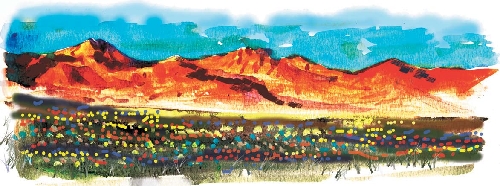Death Valley springs to life during cooler months
When winter's cold slows the pulse of many other national parks, Death Valley is in the midst of its busiest season.
Although the park is open year-round, generally balmy temperatures lure most of Death Valley's nearly 1 million annual visitors between late October and mid-May. Visitors pay a $20 entrance fee or use federal recreation passes.
The closest national park to Las Vegas, Death Valley is 150 miles away by the shortest route. Reach the heart of the park at Furnace Creek by using a route that follows Nevada Route 160 to Pahrump, then a shortcut from Pahrump to Death Valley Junction on Bell Vista Road and California Route 190 into Death Valley.
Other approaches include highways from Beatty, Lathrop Wells, Scotty's Junction off U.S. Highway 95, as well as from the south on California Route 127 and Route 178.
Impressive desert scenery lies along any route one chooses to reach Death Valley, the largest national park in the lower 48 states. Rugged mountain ranges face each other across great valleys with sparse vegetation. The arid landscape appears to be stripped to the bare bones of naked stone. Rocky deposits from mountain canyons spread out in vast alluvial fans. Wind-swept sands gather in undulating dunes. Dry lakes bleach valley floors.
But appearances deceive, for the park also contains hundreds of hidden springs and seeps, a few creeks and even a significant year-round waterfall. A few rains change the landscape with swathes of bright color during a good wildflower season.
Visitors this season will have the benefit of a major renovation project at the Furnace Creek Visitor Center that took more than a year to complete. While preserving the midcentury modern style of the 50-year-old visitor center, the project made the structure much more energy efficient, increased the size of the lobby, updated the theater, improved parking and traffic flow and added new exhibits and restrooms.
The new theater shows a fresh introductory film narrated by actor Donald Sutherland.
Exhibits emphasize the park's natural features and acknowledge the indigenous Timbisha Shoshone, whose culture developed in the harsh conditions of Death Valley.
The exhibits also explain the valley's claims as the hottest, driest and lowest place on the continent. Death Valley's highest recorded temperature of 134 degrees in July 1913 makes it the hottest spot on Earth. The valley averages fewer than two inches of precipitation annually. At 282 feet below sea level, Badwater, just south of Furnace Creek, is the lowest spot in North America.
It also can get pretty cold in Death Valley; a record low temperature of 15 degrees was set earlier this month.
Check at the visitor center for scheduled programs, hikes and guided activities, including popular dark-sky astronomical observations and full-moon outings.
Other improvements in the park may not be as evident as those at Furnace Creek. Over the past 150 years, mining in the park left hundreds of mine shafts, tunnels and prospect holes open and unsafe. Work continues to improve safety for visitors by identifying and closing off these hazards. The Keane Wonder Mine has been shut down because of safety concerns and should reopen when stabilization is completed.
Death Valley continues to be a favorite with campers. The park's nine campgrounds provide 791 designated sites. Four are open year-round, and the rest are seasonally accessible. Fees in the five larger campgrounds range from $12 to $18 per night, while campsites are free of charge at 49 sites in the four smaller campgrounds. Campers can reserve sites at Furnace Creek Campground up to six months in advance by calling 877-444-6777 or online at recreation.gov.
Other overnight visitors prefer accommodations inside the park at the historic Furnace Creek Inn or the cabins or motel at Furnace Creek Ranch, run by Xanterra Parks and Resorts. Accommodations at Stovepipe Wells are operated by the Death Valley Lodging Co. Make reservations by phone or online well in advance of your visit. Developed facilities include stores, snack bars, restaurants and lounges.
Margo Bartlett Pesek's Trip of the Week column appears on Sundays.






















